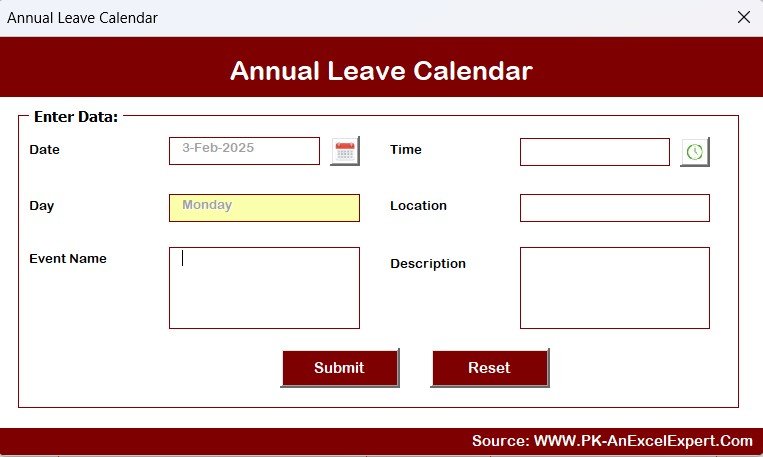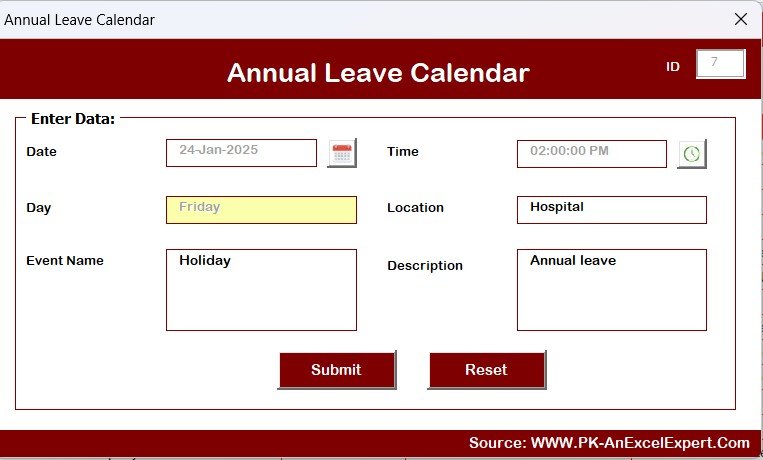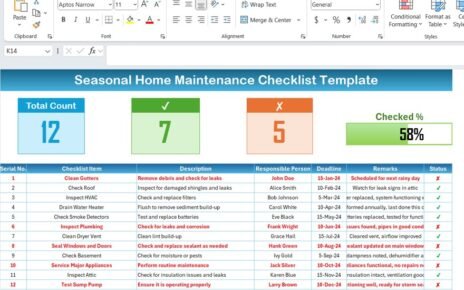Keeping track of employee leave and important events in a business or personal context is crucial for effective time management. Using an organized system ensures that you never miss a day or event that requires attention. One powerful tool to manage such schedules is an Annual Leave Calendar in Excel. This tool allows users to visually track leave days, events, and important dates throughout the year.
In this article, we’ll guide you through the creation of an Annual Leave Calendar in Excel, its key features, and how to make the most of it for efficient calendar management. Whether you are managing personal leave, employee attendance, or planning important events, this template will make your task easier and more organized.
Why Use an Annual Leave Calendar in Excel?
Before diving into the features of the template, let’s first understand why using Excel to manage an annual leave calendar is beneficial:
- Customization – Excel gives you full control over the layout, making it easy to tailor the calendar to your specific needs.
- Flexibility – It allows users to update leave records or add new events in real-time.
- Efficiency – A well-organized calendar ensures that leave management becomes more systematic and less prone to errors.
- Accessibility – Since most people are familiar with Excel, there’s no steep learning curve to use it effectively.
Key Features of the Annual Leave Calendar in Excel
Our Annual Leave Calendar in Excel is a ready-to-use tool designed for both personal and professional use. It’s structured in a way that makes tracking leave, events, and other dates simple and intuitive. Below, we’ll discuss the key features of the calendar template.
1. Home Sheet: The Central Hub
The Home Sheet serves as the index page of the entire calendar. This sheet provides quick access to the other sections of the workbook through navigation buttons.
Navigation Buttons:
- Annual View: Takes you to the full year’s calendar for a broad overview.
- Monthly View: Displays the calendar of a specific month.
- Daily View: Shows a detailed view of events by date range.
- Events: Provides access to the events database for adding and managing events.

Click to Annual Leave
2. Annual View Sheet: A Year at a Glance
The Annual View Sheet displays all 12 months of the year in one place. It’s perfect for visualizing the year’s calendar in its entirety, helping you track leave days and key events across the months.

Click to Annual Leave
Key Features:
Control Panel: The control panel in this view allows you to adjust various settings, such as:
- Select the year.
- Change the starting month.
- Alter the starting day of the week (e.g., start the calendar on Monday or Sunday).

Click to Annual Leave
Change Theme Group: Choose from five color themes to apply a uniform look throughout the workbook.
Highlight Group: Highlight weekends or specific days (such as public holidays) in different colors. You can also opt to highlight events in yellow.
Event Management:
- Add New Event: By selecting a date on the calendar, you can click the “Add New Event” button to open a form where you can enter event details like the event name, time, and location.

Click to Annual Leave
- Show Event: This feature lets you view all events scheduled for a particular date.
3. Monthly View Sheet: Detailed View of One Month
For a more focused view, the Monthly View Sheet shows a calendar for a selected month. This is useful for users who want to drill down into specific months and track events or leaves within that month.
Event Handling:
- Add New Event: Like the Annual View, you can easily add new events by selecting the date and entering event details.
- Show Event: View a list of events for any selected date.

Click to Annual Leave
4. Daily View Sheet: View Events by Date Range
The Daily View Sheet allows users to manage and view events over a specific date range. You can input the start and end dates to view events that fall between these dates.
Features:
- Date Range Selection: Select the date range using a calendar icon, and the system will automatically display all events for the selected period.
- Add New Event: Like the other views, you can add events for any selected date in the daily view.

Click to Annual Leave
5. Events Sheet: The Database
The Events Sheet is where all the event data is stored in a structured format. This sheet helps you manage the details of all your events in one place.
Key Data:
- ID: Auto-generated unique identifier for each event.
- Date: The date of the event.
- Day: The day of the week on which the event falls (e.g., Monday, Tuesday).
- Event Name: Name of the event (e.g., “Annual Leave”).
- Time: Time of the event.
- Location: Venue of the event.
- Description: A brief description of the event.

Click to Annual Leave
Buttons for Management:
- Add New Record: Adds a new event by filling out a form.

Click to Annual Leave
- Update Existing Record: Allows you to update an existing event by selecting the event ID.

Click to Annual Leave
- Delete Record: Deletes an event from the database.
Advantages of Using an Annual Leave Calendar in Excel
There are many benefits to using an Annual Leave Calendar in Excel, including:
- Easy Tracking: Keeps track of all leave days and important events in one centralized location.
- Customizable: Modify the calendar to suit your needs—whether it’s adjusting the starting month or highlighting specific days.
- Efficient Time Management: With clear visibility into the entire year’s schedule, you can plan ahead for leave, holidays, and special events.
- User-Friendly: The design is simple and intuitive, making it easy for anyone to use, regardless of their Excel proficiency.
- Comprehensive: From a yearly overview to daily details, the template covers all aspects of leave management and event planning.
Opportunities for Improvement in the Annual Leave Calendar
Although the Annual Leave Calendar in Excel is highly functional, there are always opportunities for improvement:
- Integration with Other Tools: It could be enhanced by integrating with other productivity tools like Google Calendar or Outlook to sync events automatically.
- Mobile Compatibility: Making the calendar fully mobile-friendly would enable users to access and update their leave schedules from any device.
- Advanced Customization: While the current themes are useful, adding more color themes or customizable designs could give users more control over the appearance of their calendar.
- Leave Balance Calculation: Adding automatic leave balance calculations (e.g., based on the number of leave days taken) could provide additional functionality.
Best Practices for Using an Annual Leave Calendar in Excel
To get the most out of your Annual Leave Calendar in Excel, consider the following best practices:
- Regular Updates: Make sure to update the calendar regularly with new leave requests or changes to events. Keeping it up-to-date ensures that you always have an accurate overview.
- Use Color Coding: Use color themes and highlight features to visually separate different types of events, such as public holidays, personal leave, or special work-related events.
- Backup Your Data: Since the calendar contains important event and leave data, regularly back it up to prevent data loss.
- Keep It Simple: Don’t overcrowd the calendar with too much information. Stick to essential details to ensure that the calendar remains easy to navigate.
- Train Your Team: If you’re using the calendar for a team, ensure everyone knows how to add, update, or delete events. Proper training will prevent mistakes and streamline the process.
Conclusion
An Annual Leave Calendar in Excel is a powerful and efficient tool for tracking leave and events. By leveraging its key features such as the annual, monthly, and daily views, users can maintain a clear and organized calendar that can be customized to fit specific needs. Whether for personal use or within a business context, this Excel template simplifies event and leave management, enhancing productivity and time management.
With continuous improvements and by following the best practices mentioned, you can ensure that your calendar remains an effective tool for planning and organizing important dates.
Frequently Asked Questions (FAQs)
How do I add a new event to the Annual Leave Calendar in Excel?
You can add a new event by selecting a date on the calendar and clicking the “Add New Event” button. A form will pop up where you can fill out the event details and submit them.
Can I change the theme of the calendar?
Yes, the calendar allows you to change the theme using the Change Theme Group in the Annual View sheet. You can select from five available color themes.
How do I view events for a specific date range?
To view events for a specific date range, go to the Daily View Sheet. Enter the start and end dates, click on the calendar icons, and hit the Refresh button to see the events for that period.
Can I delete an event from the calendar?
Yes, you can delete an event by selecting its ID from the Events Sheet and clicking the Delete Record button.
Can I use this calendar for multiple years?
Absolutely! The calendar is designed to be used for any year. You can change the year, starting month, and starting day of the week using the control panel in the Annual View Sheet
Visit our YouTube channel to learn step-by-step video tutorials


